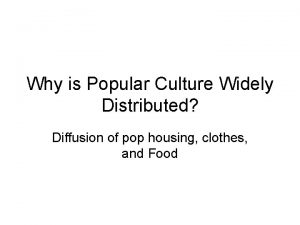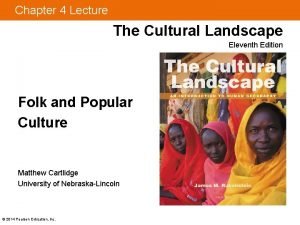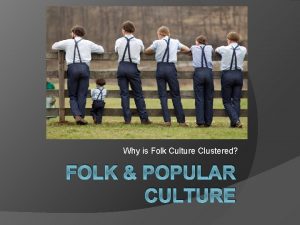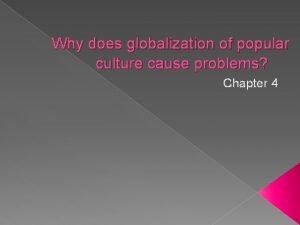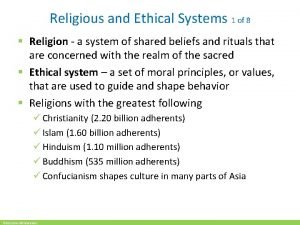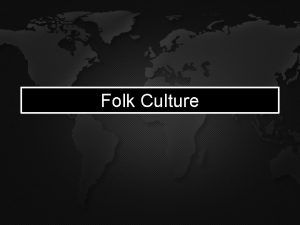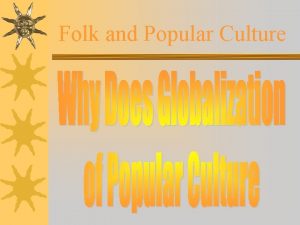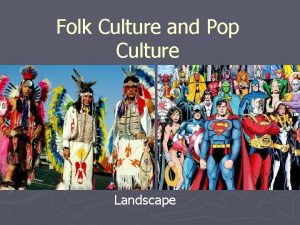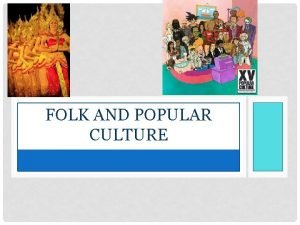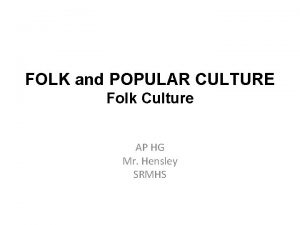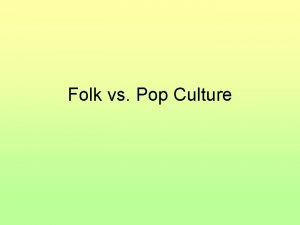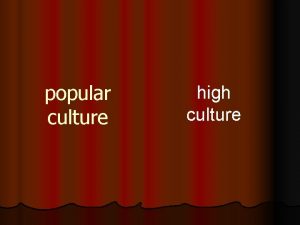Folk Popular Culture Why is Popular Culture Widely

















- Slides: 17

Folk & Popular Culture Why is Popular Culture Widely Distributed?

l Popular culture varies more in time than in place l l What does this mean? ? ? Material Posessions Unlike folk culture, pop culture does NOT reflect the local environment; looks the same everywhere Some regional differences in MDCs, but much less than in past; l l l Food Clothing Shelter

Popular Housing Styles l l Influences of shapes, materials, detailing etc. Modern house styles (1945 -60) l l “Family room” added in 1950 s Neo-eclectic house styles (since 1960)

Clothing Styles l l Clothing habits as reflection of type of work rather than environment (suit vs. jeans) Higher income = up-to-date wardrobe (especially women) l l Communication speed, manufacturing Diffusion; Travel, TV, Internet

Can you think of a clothing style that was adopted from folk costume?

Jeans l Became mainstream in US in 1960 s l l Price of jeans? ? l l l Used to be associated with low status, manual laborers $10 -? ? Value of Levi’s around the world What do jeans have to do with communism? ?

Popular Food Customs l l l Consumption patterns of alcohol & snack-foods Fast-food/Restaurants Variations within US much less significant than differences between US & LDCs

l Regional Differences within the United States l Americans may choose beverages or snacks based on what is produced, grown, or imported locally. l l Wine consumption relatively high in California where most of the U. S. production is located. Cultural backgrounds affect the amount and types of alcohol and snack foods consumed. l Relatively little alcohol is consumed in Utah because of the strong presence of the Church of Latter-day Saints that advocates against drinking alcohol. § l High consumption in Nevada where resorts located. Texans may prefer tortilla chips in greater numbers because of strong Hispanic American presence.

Alcohol Preferences in the U. S. Fig. 4 -12: Per capita consumption of rum (top) and Canadian whiskey (bottom) show different distributions and histories of diffusion.

Popular Food Culture l Differences among Countries l Cola preferences can be influenced by politics. l l l Soviet Union: Pepsi permitted for sale in country Russia: Many former Soviets switched to Coke, because Pepsi was associated with communism. Cola preferences can be influenced by religion. l Southwest Asia: Predominantly Muslim countries boycotted products sold in Jewish Israel—e. g. , Coke

Diffusing Popular Culture Through TV l Significant pop. custom for 2 reasons l l Most popular leisure activity in MDCs Most important mechanism for diffusing culture Diffusion from the United States to the rest of the world = 50 years Internet follows similar pattern l l More rapid pace Diffusion from the United States to the rest of the world = 10 years

Diffusion of TV, 1954– 1999 Fig. 4 -14: Television has diffused widely since the 1950 s, but some areas still have low numbers of TVs per population.

Diffusion of the Internet: Late Twentieth Century l l In 1995, Internet users in the United States accounted for more than half of the global users. By 2011, 77 percent of the U. S. population accessed the Internet. l Accounted for 10 percent of the global users. l Global share decreased by roughly 40 percent in less than 10 years.

Diffusion of Social Media: Twenty-First Century l Same diffusion pattern as TV and Internet l Facebook l l l In 2008, Facebook users in United States consisted of 1/3 of all global users. By 2011, global share decreased to 1/5. Twitter l l United States was source of 1/3 of all tweets in 2010. Second leader of tweets is India.

Diffusion of Facebook Figure 4 -21


Gov’t Control of TV l Private corporations vs. Government owned l l How do they make $$ l l CTV, City. TV, VS. CBC, TVO Ads, licenses Satellites banned (China, Saudi Arabia) l Gov’t censorship
 Why is popular culture widely distributed
Why is popular culture widely distributed Folk culture and popular culture venn diagram
Folk culture and popular culture venn diagram Examples of mass culture
Examples of mass culture Folk culture and popular culture venn diagram
Folk culture and popular culture venn diagram Why is access to folk and popular culture unequal
Why is access to folk and popular culture unequal Folk and popular culture
Folk and popular culture Folk and popular culture
Folk and popular culture What is folk local cultur
What is folk local cultur How do the origins of folk and popular culture differ
How do the origins of folk and popular culture differ Diffusion of folk culture
Diffusion of folk culture Examples of folk and popular culture
Examples of folk and popular culture Habit ap human geography
Habit ap human geography Why is folk culture clustered?
Why is folk culture clustered? Why do ldcs fear the loss of folk culture
Why do ldcs fear the loss of folk culture Andreas carlsson bye bye bye
Andreas carlsson bye bye bye Why does globalization of popular culture cause problems
Why does globalization of popular culture cause problems Biomedical therapies
Biomedical therapies Most widely practiced religion
Most widely practiced religion
